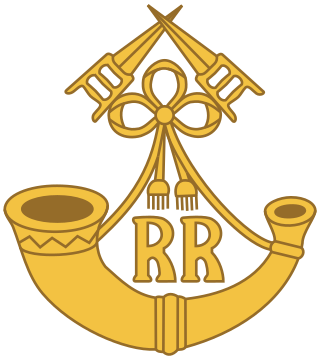
The Rajputana Rifles is the oldest rifle regiment of the Indian Army. It was originally a part of the British Indian Army, when six previously existing regiments were amalgamated to form six battalions of the 6th Rajputana Rifles. In 1945, the numeral designation was dropped from the title and in 1947 the regiment was transferred to the newly independent Indian Army. Since independence, the regiment has been involved in a number of conflicts against Pakistan, as well as contributing to the Custodian Force (India) in Korea under the aegis of the United Nations in 1953–54 and to the UN Mission to the Congo in 1962. As a rifle regiment, it uses a bugle horn as its insignia, the same as the British Light Division, but unlike its British counterparts, the Rajputana Rifles march at the same march pace used in the Indian Army as a whole.

The 11 Gorkha Rifles is a Gorkha regiment of the Indian Army that was re-raised after independence. The regiment consists of primarily the Kirant Tribes Rai, Limbu, Yakkha, Sunuwar of Eastern Nepal, Darjeeling, Kalimpong, Dooars of West Bengal, Sikkim and other parts of Northeast India. Though it is considered to be the youngest of the Gorkha regiments its lineage is as long as those of the 7th Gurkha Rifles and 10th Gurkha Rifles.

The Jat Regiment is an infantry regiment of the Indian Army, of which it is one of the longest-serving and most decorated regiments. The regiment has won 19 battle honours between 1839 and 1947, and post-independence it has won five battle honours, including 2 Victoria Cross, 8 Mahavir Chakra, 8 Kirti Chakra, 34 Shaurya Chakras, 39 Vir Chakras and 253 Sena Medals. During its 200-year service history, the regiment has participated in various actions and operations in India and abroad, including the First and the Second World Wars. Numerous battalions of the Jat Regiment, including the 14th Murray's Jat Lancers, fought in the First World War.
The Battle of Tololing was a pivotal battle in the Kargil War between India and troops from one full battalion of Pakistan’s Northern Light Infantry who were aided by Pakistani irregulars in 1999.
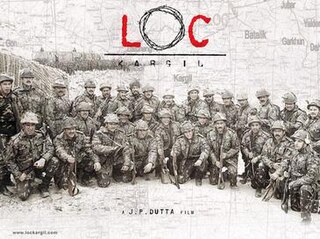
LOC Kargil is a 2003 Indian Hindi-language historical war film based on the Kargil War fought between India and Pakistan, produced and directed by J. P. Dutta under his banner "J. P. Films". The film features an ensemble cast of Bollywood stars and music composed by Aadesh Shrivastava and Anu Malik, with the former composing the score and the latter composing the songs.
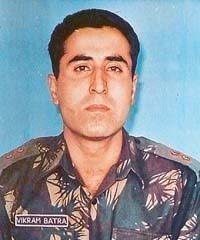
Vikram Batra was an Indian Army officer. He was posthumously awarded the Param Vir Chakra, the highest Indian military decoration, for his actions during the Kargil War; on 7 July 1999, Batra was killed while fighting Pakistani troops around Area Ledge, Point 4875, in the Kargil district of erstwhile Jammu and Kashmir.
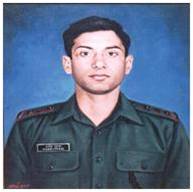
Captain Manoj Kumar Pandey, PVC was an Indian military officer posthumous recipient of India's highest military decoration, the Param Vir Chakra, for his audacious courage and leadership during the Kargil War in 1999. An officer of the first battalion in the 11th Gorkha Rifles, he sacrificed his life for the nation in battle on the bunker hill edge of the Khalubar Hills in the village of Garkon Aryan Valley in Kargil.

The Garhwal Rifles, formerly known as the Royal Garhwal Rifles, are an infantry regiment of the Indian Army. It was originally raised in 1887 as the 39th (Garhwal) Regiment of the Bengal Army. It then became part of the British Indian Army, and after the Independence of India, it was incorporated into the Indian Army.
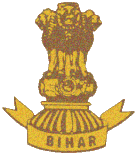
The Bihar Regiment is an Indian Army infantry regiment. It traces its origins back to the British Indian Army. The Bihar Regiment was formed in 1941 by regularising the 11th (Territorial) Battalion, the 19th Hyderabad Regiment, and raising new battalions. The Bihar Regimental Centre (BRC) is located at Danapur Cantonment, Patna, the second oldest cantonment of India. INS Vikramaditya, the Indian Navy's largest ship and one of its two aircraft carriers is affiliated to the Bihar Regiment, Indian Army's highly decorated and battle-hardened unit.

Major Rajesh Singh Adhikari, MVC, was an Indian Army officer who died during the Kargil War. He was posthumously awarded the second highest Indian military honour, the Maha Vir Chakra for bravery on the battlefield.

Major Padmapani Acharya, MVC was an officer in the Indian Army. He was awarded the second highest Indian military honour, Maha Vir Chakra posthumously for his actions during the Kargil War on 28 June 1999.

Lieutenant General Yogesh Kumar Joshi, PVSM, UYSM, AVSM, VrC, SM, ADC is a retired General Officer of the Indian Army. He was the General Officer Commanding-in-Chief Northern Command, assuming office from Lt Gen Ranbir Singh on 1 February 2020. He last served as the Chief of staff of the Northern Command, assuming the office from Lt Gen SK Sharma. Previously, he was the commander of Leh based Fire & Fury Corps. As Army Commander he is credited with spearheading the Indian response to PLA's attempt to alter the status quo on Line of Actual Control (LAC) by use of force. He is the only war decorated Army Commander who has to his credit successes against both Indian adversaries China and Pakistan.
Havildar Bhim Bahadur Dewan was the leading section commander of 1/11 Gorkha Rifles under Captain Manoj Kumar Pandey, who was tasked to capture "Khalubar South" on 3 July 1999. He was awarded Vir Chakra (posthumously) for his contribution in Operation Vijay against Pakistani Army
Lieutenant Colonel Ramakrishnan Vishwanathan, VrC was the second-in-command of 18 Grenadiers which was conducting operations on and around Tololing mountain, Drass sector, Kargil, during Operation Vijay. He was posthumously awarded the Vir Chakra for his actions during the Kargil War. A Tripunithura a street near Eroor Pisharikovil Temple is named in his honour.

Captain Neikezhakuo Kengurüse, MVC was an Indian Army officer from Nagaland.

The 54th Infantry Division is an Infantry division of the Indian Army. The Division was raised as an Infantry Division, but was converted into a Reorganised Amphibious Formation (RAMFOR) in 2011. It is currently the only division of the Indian Army which carries out Amphibious warfare. The division is headquartered at Secunderabad in Telangana and is a part of XXI Corps. The Division is commanded by a Two-star General Officer of the rank of Major General titled General Officer Commanding (GOC).

Major General Samir Kumar Chakravorty, AVSM, SC, SM & bar is a former General Officer of the Indian Army. He last served as the General officer commanding 28 Infantry Division. During the Kargil War in 1999, he commanded 18 Garhwal Rifles which received the Chief of the Army Staff’s unit citation and the Battle Honour Drass and the Theatre Honour Kargil for feats of gallant action.
Major Vivek Gupta MVC was an officer in the Indian Army. He was posthumously conferred the Maha Vir Chakra, India's second highest war-time military honour, for his actions during the 1999 Kargil War.
Major Ajay Singh Jasrotia, SM was an Indian military officer with the 13 Jammu and Kashmir Rifles who laid down his life during Kargil War to save the lives of his six comrades.

Captain Jintu Gogoi, VrC was an Indian Army officer of 17 Garhwal Rifles. He was posthumously awarded the Vir Chakra, India's third highest wartime military decoration, for his courage and bravery in combat during operations in the Kargil War in 1999.















